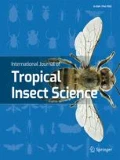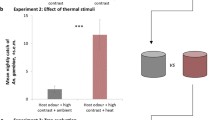Abstract
Examples from recent literature are used to discuss the host location behaviour of tsetse in relation to feeding patterns. Tsetse recognise potential hosts by their visual and olfactory characteristics. These, and mechanical stimulation, will activate tsetse and initiate host-oriented responses. Approach to a stationary host is by upwind flight modulated by olfactory stimuli with visual responses only at short range, while the approach to a moving host is largely mediated by visual input. Non-random feeding patterns, even where host and tsetse occupy the same habitat, may be explained by host responses to tsetse attack. There is little evidence of long range discrimination between hosts. Some epidemiological implications of the resulting feeding patterns are discussed, and the host location behaviour of tsetse is compared with that of other insects including mosquitoes.
Similar content being viewed by others
References
Ashcroft M. T. (1959) The importance of African wild animals as reservoirs of trypanosomiasis. E.A. med. J. 36, 289–297.
Boreham P. F. L. (1972) Recent developments in, and possible future applications of the identification of blood-meals in vectors of African trypanosomiasis. WHO/TRYP/WP/72.6
Bossert W. H. and Wilson E. O. (1963) The analysis of olfactory communication among animals. J. theor. Biol. 5, 443–69.
Bradbury W. C. and Bennett G. F. (1974) Behaviour of adult Simuliidae (Diptera). II. Vision and olfaction in near-orientation and landing. Can. J. Zool. 52, 1355–1364.
Brady J. (1975) ‘Hunger’ in the tsetse fly: the nutritional correlates of behaviour. J. Insect Physiol. 21, 807–829.
Brady J. and Crump J. A. (1978) The control of circadian rhythms in tsetse flies: environment or physiological clock? Physiol. Entomol. 3, 177–190.
Brown A. W. A. (1951) Studies of the responses of the female Aedes mosquito. Part IV. Field experiments on Canadian species. Bull. em. Res. 42, 575–582.
Bursell E. (1970) Dispersal and concentration of Glossina. In The African Trypanosomiases (Ed. by Mulligan H. W.), 950 pp. Allen & Unwin, London.
Challier A. (1977) Trapping technology. In Tsetse. The Future for Biological Methods in Integrated Control (Ed. by Laird M.). IDRC-077e, Ottawa.
Chapman R. F. (1961) Some experiments to determine the methods used in host finding by the tsetse fly. Glossina medicorum. Bull. ent. Res. 52, 83–97.
Cuthbert R. A. and Peacock J. W. (1978) Response of the elm bark beetle, Scolytus multistriatus (Coleóptera: Scolytidae) to component mixtures and doses of the pheromone, multilure. J. chem. Ecol. 4, 363–372.
Dean G. J. W., Clements S. A. and Paget J. (1969) Observations on some possible attractants of tsetse flies (G. morsitans Westw. and G. pallidipes Aust.) Bull. ent. Res. 59, 423–434.
Dorst J. and Dandelot P. (1970) A Field Guide to The Larger Mammals of Africa, 287 pp. Collins. London.
Fiske W. F. (1920) Investigations into the bionomics of Glossina palpalis. Bull. ent. Res. 10, 347–463.
Ford J. (1971) The Role of the Trypanosomiases in African Ecology. A Study of the Tsetse Fly Problem, 568 pp. Clarendon Press, Oxford.
Frezil J.-L. and Carnevale P. (1976) Utilisation de la carboglace pour la capture de Glossina fuscipes quan-:ensis Pires, 1948, avec la piège Challier-Laveissiere. Consequences epidemiologiques. Cah. O.R.S.T.O.M. ser. Ent. med. Parasitol. 14, 225–233.
Gatehouse A. G. (1972) Host-finding behaviour of tsetse flies. In E. U. Canning & C. A. Wright (Eds.). Behavioural aspects of parasite transmission. Zool. J. Linn. Soc. 51, Suppl. 1, 83–95.
Gillies M. T. (1972) Some aspects of mosquito behaviour in relation to the transmission of parasites. In E. U. Canning & C. A. Wright (Eds.). Behavioural aspects of parasite transmission. Zool. J. Linn. Soc. 51, Suppl. 1, 69–81.
Gillies M. T. and Wilkes T. J. (1969) A comparison of the range of attraction of animal baits and of carbon dioxide for some West African mosquitoes. Bull. ent. Res. 59, 441–456.
Gillies M. T. and Wilkes T. J. (1972) The range of attraction of animal baits and carbon dioxide for mosquitoes. Studies in a freshwater area of West Africa. Bull. ent. Res. 61, 389–404.
Gillies M. T. and Wilkes T. J. (1974) The range of attraction of birds as baits for some West African mosquitoes. Bull. ent. Res. 63, 573–581.
Glasgow J. P. (1963) The Distribution and Abundance of Tsetse, 241 pp. Pergamon Press, London.
Hargrove J. W. (1976) The effect of human presence on the behaviour of tsetse (Glossina spp.) (Diptera, Glossini-dae) near a stationary ox. Bull. ent. Res. 66, 173–178.
Hargrove J. W. and Vale G. A. (1978) The effect of host odour concentration on catches of tsetse flies (Glossini-dae) and other Diptera in the field. Bull. ent. Res. 68, 607–612.
Jackson C. H. N. (1930) Contributions to the bionomics of Glossina morsitans. Bull. ent. Res. 21, 491–527.
Jordan A. M. (1965) The hosts of Glossina as the main factor affecting trypanosome infection rates of tsetse flies in Nigeria. Trans. R. Soc. trop. Med. Hyg. 59, 423–431.
Kennedy J. S. (1978) The concepts of olfactory “arrestment” and “attraction”. Physiol. Entomol. 3, 91–98.
Lambrecht F. L. (1973) Colour attraction of Glossina morsitans in N’gamiland, Botswana. J. trop. Med. Hvg. 76, 94–96.
Lamprey H. F., Glasgow J. P., Lee-Jones F. and Weitz B. (1962) A simultaneous census of the potential and actual food sources of the tsetse fly Glossina swynnertoni Aus-ten. J. anim. Ecol. 31, 151–156.
Lewis T. and Macaulay E. D. M. (1976) Design and evaluation of sex attractant traps for pea moth. Cydia nigricana (Steph.) and the effect of plume shape on catches. Ecol. Entomol. 1, 175–187.
Lloyd H. M. (1935) Notes on the bionomics of Glossina swynnertoni Austen. Bull ent. Res. 26, 439–468.
Marsh D., Kennedy J. S. and Ludlow A. R. (1978) An analysis of anemotactic zigzagging flight in male moths stimulated by a pheromone. Physiol, entomol. 3, 221–240.
Moloo S. K. (1973) Relationship between hosts and trypanosome infection rates of Glossina swynnertoni Aust. in the Serengeti National Park, Tanzania. Ann. trop. Med. Parasitol. 67, 205–211.
Moloo S. K., Steiger R. F., Brun R. and Boreham P. F. L. (1971) Sleeping sickness survey in Musoma District Tanzania. II. The role of Glossina in the transmission of sleeping sickness. Acta trop. 28, 189–205.
Napier-Bax S. (1937) The senses of smell and sight in Glossina swynnertoni. Bull. ent. Res. 28, 539–582.
Ramsdell J. V. and Hinds W. T. (1971) Concentration fluctuations and peak-to-mean concentration ratios in plumes from a ground-level continuous point source. Atmos. Environ. 5, 483–495.
Rogers A. (1970) The use of dry ice in trapping tsetse. Rep. E.A.Tr.O. 1969, 85–90.
Saunders D. S. (1967) Survival and reproduction in a natural population of the tsetse fly, Glossina palpalis palpalis (Robineau-Desvoidy). Proc. R. ent. Soc. Lond. (A) 42, 129–137.
Shorey H. H. (1970) Sex pheromones of Lepidoptera. In Control of Insect Behaviour by Natural Products (Ed. by Wood D. L., Silverstein R. M. and Nakajima M.), 345 pp. Academic Press, New York.
Sippell W. L. and Brown A. W. A. (1953) Studies of the responses of the female Aedes mosquito. Part V. The role of visual factors. Bull. ent. Res. 43, 567–574.
Thompson B. H. (1976) Studies on the attraction of Simulium damnosum s.l. (Diptera: Simuliidae) to its hosts. I. The relative importance of sight, exhaled breath and smell. Tropenmed. Parasitol. 27, 455–473.
Turner D. A. (1971) Olfactory perception of live hosts and carbon dioxide by the tsetse fly Glossina morsitans orientalis Vanderplank. Bull. ent. Res. 61, 75–96.
Turner D. A. and Invest J. F. (1973) Laboratory analyses of vision in tsetse flies (Dipt., Glossinidae). Bull. ent. Res. 62, 343–357.
Vale G. A. (1974a) The responses of tsetse flies (Diptera, Glossinidae) to mobile and stationary baits. Bull. ent. Res. 64, 545–588.
Vale G. A. (1974b) Direct observations on the responses of tsetse flies (Diptera, Glossinidae) to hosts. Bull. ent. Res. 64, 589–594.
Vale G. A. (1977a) The flight of tsetse flies (Diptera: Glossinidae) to and from a stationary ox. Bull. ent. Res. 67, 297–303.
Vale G. A. (1977b) Feeding responses of tsetse flies (Diptera: Glossinidae) to stationary hosts. Bull. ent. Res. 67, 635–649.
Vale G. A. and Cumming D. H. M. (1976) The effects of selective elimination of hosts on a population of tsetse flies (Glossina morsitans morsitans Westwood (Diptera. Glossinidae)). Bull. ent. Res. 66, 713–729.
Wright R. H. (1958) The olfactory guidance of flying insects. Can. Entomol. 90, 81–89.
Weitz B. (1963) The feeding habits of Glossina. Bull. Wld. Hlth. Org. 28, 711–729.
Author information
Authors and Affiliations
Rights and permissions
About this article
Cite this article
Snow, W.F. Host Location and Feeding Patterns in Tsetse. Int J Trop Insect Sci 1, 23–30 (1980). https://doi.org/10.1017/S1742758400000084
Published:
Issue Date:
DOI: https://doi.org/10.1017/S1742758400000084




